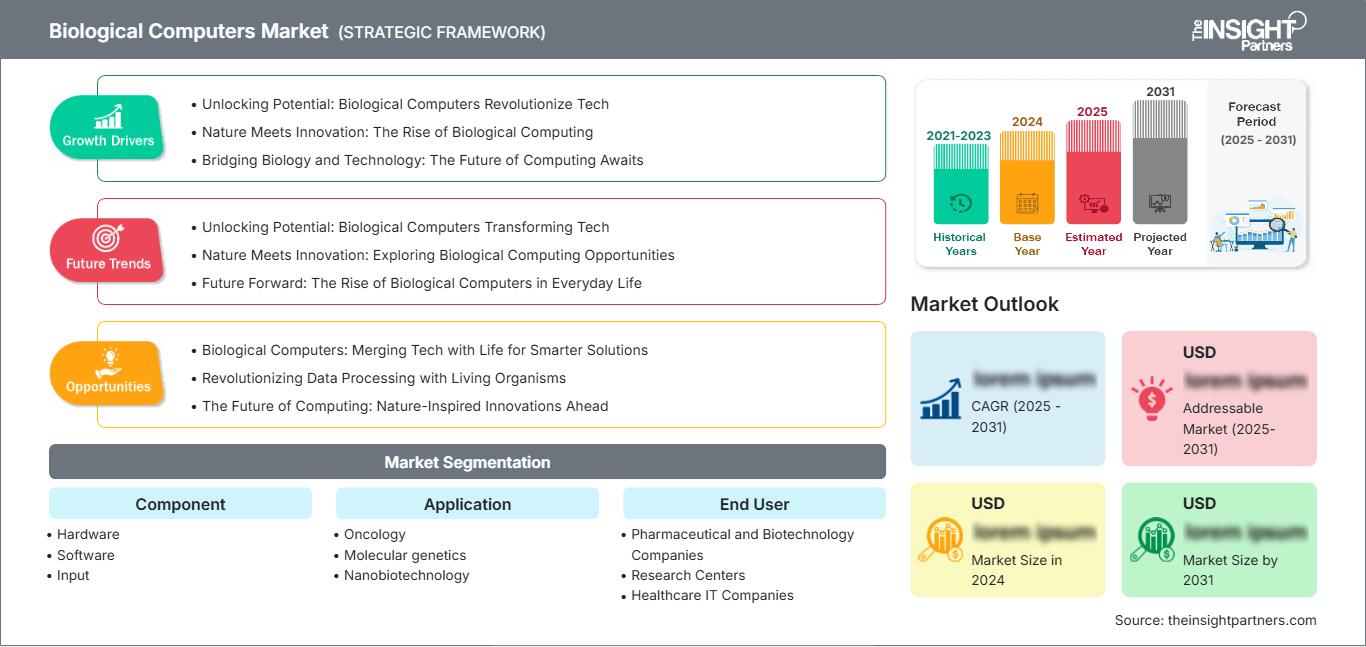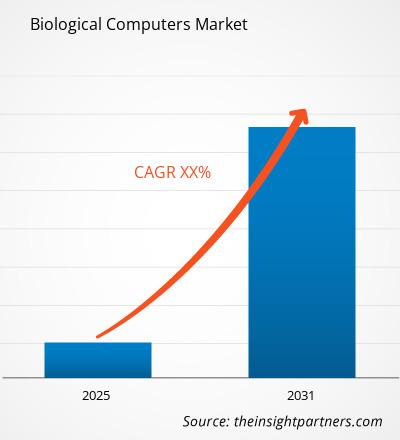Si prevede che il mercato dei computer biologici registrerà un CAGR del XX% dal 2025 al 2031, con una dimensione del mercato in espansione da XX milioni di dollari nel 2024 a XX milioni di dollari entro il 2031.
Il rapporto è suddiviso per componente (hardware, software, input, output) e analizza ulteriormente il mercato in base all'applicazione (oncologia, genetica molecolare, nanobiotecnologia). Esamina inoltre il mercato per utente finale (aziende farmaceutiche e biotecnologiche, centri di ricerca, aziende IT sanitarie, ospedali e cliniche). Viene fornita una ripartizione completa a livello globale, regionale e nazionale per ciascuno di questi segmenti chiave. Il rapporto include le dimensioni del mercato e le previsioni per tutti i segmenti, presentando i valori in dollari statunitensi. Fornisce inoltre statistiche chiave sullo stato attuale del mercato dei principali attori, insieme ad approfondimenti sulle tendenze prevalenti e sulle opportunità emergenti.
Scopo del rapporto
Il rapporto "Biological Computers Market" di The Insight Partners mira a descrivere il panorama attuale e la crescita futura, i principali fattori trainanti, le sfide e le opportunità. Ciò fornirà spunti a vari stakeholder aziendali, come:
- Fornitori/Produttori di tecnologia: per comprendere le dinamiche di mercato in evoluzione e conoscere le potenziali opportunità di crescita, consentendo loro di prendere decisioni strategiche informate.
- Investitori: per condurre un'analisi completa delle tendenze in merito al tasso di crescita del mercato, alle proiezioni finanziarie di mercato e alle opportunità esistenti lungo la catena del valore.
- Enti di regolamentazione: per regolamentare le politiche e le attività di controllo sul mercato con l'obiettivo di ridurre al minimo gli abusi, preservare la fiducia degli investitori e sostenere l'integrità e la stabilità del mercato.
Componente di segmentazione del mercato dei computer biologici
- Hardware
- Software
- Input
- Output
Applicazione
- Oncologia
- Genetica molecolare
- Nanobiotecnologia
Utente finale
- Aziende farmaceutiche e biotecnologiche
- Centri di ricerca
- Aziende IT sanitarie
- Ospedali e cliniche
Potrai personalizzare gratuitamente qualsiasi rapporto, comprese parti di questo rapporto, o analisi a livello di paese, pacchetto dati Excel, oltre a usufruire di grandi offerte e sconti per start-up e università
Mercato dei computer biologici: Approfondimenti strategici

- Ottieni le principali tendenze chiave del mercato di questo rapporto.Questo campione GRATUITO includerà l'analisi dei dati, che vanno dalle tendenze di mercato alle stime e alle previsioni.
Fattori di crescita del mercato dei computer biologici
- Sbloccare il potenziale: i computer biologici rivoluzionano la tecnologia
- La natura incontra l'innovazione: l'ascesa del computer biologico
- Unire biologia e tecnologia: il futuro dell'informatica ci attende
Tendenze future del mercato dei computer biologici
- Sbloccare il potenziale: i computer biologici trasformano la tecnologia
- La natura incontra l'innovazione: esplorare le opportunità del computer biologico
- Futuro in avanti: l'ascesa dei computer biologici nella vita di tutti i giorni
Opportunità di mercato dei computer biologici
- Computer biologici: unire tecnologia e vita per soluzioni più intelligenti
- Rivoluzionare l'elaborazione dei dati con gli organismi viventi
- Il futuro di Informatica: innovazioni ispirate alla natura
Mercato dei computer biologici
Le tendenze regionali e i fattori che influenzano il mercato dei computer biologici durante il periodo di previsione sono stati ampiamente spiegati dagli analisti di The Insight Partners. Questa sezione analizza anche i segmenti e la geografia del mercato dei computer biologici in Nord America, Europa, Asia-Pacifico, Medio Oriente e Africa, America Meridionale e Centrale.
Ambito del rapporto di mercato sui computer biologici
| Attributo del rapporto | Dettagli |
|---|---|
| Dimensioni del mercato in 2024 | US$ XX million |
| Dimensioni del mercato per 2031 | US$ XX Million |
| CAGR globale (2025 - 2031) | XX% |
| Dati storici | 2021-2023 |
| Periodo di previsione | 2025-2031 |
| Segmenti coperti |
By Componente
|
| Regioni e paesi coperti | Nord America
|
| Leader di mercato e profili aziendali chiave |
|
Densità degli attori del mercato dei computer biologici: comprendere il suo impatto sulle dinamiche aziendali
Il mercato dei computer biologici è in rapida crescita, trainato dalla crescente domanda degli utenti finali, dovuta a fattori quali l'evoluzione delle preferenze dei consumatori, i progressi tecnologici e una maggiore consapevolezza dei vantaggi del prodotto. Con l'aumento della domanda, le aziende stanno ampliando la propria offerta, innovando per soddisfare le esigenze dei consumatori e sfruttando le tendenze emergenti, alimentando ulteriormente la crescita del mercato.

- Ottieni il Mercato dei computer biologici Panoramica dei principali attori chiave
Punti di forza
- Copertura completa: il rapporto analizza in modo esaustivo prodotti, servizi, tipologie e utenti finali del mercato dei computer biologici, offrendo una panoramica olistica.
- Analisi degli esperti: il rapporto è redatto sulla base della conoscenza approfondita di esperti e analisti del settore.
- Informazioni aggiornate: il rapporto garantisce la pertinenza aziendale grazie alla copertura di informazioni e tendenze dei dati recenti.
- Opzioni di personalizzazione: questo rapporto può essere personalizzato per soddisfare le esigenze specifiche del cliente e adattarsi in modo appropriato alle strategie aziendali.
Il rapporto di ricerca sul mercato dei computer biologici può quindi contribuire a guidare il percorso di decodificazione e comprensione dello scenario del settore e delle prospettive di crescita. Sebbene possano esserci alcune preoccupazioni valide, i vantaggi complessivi di questo rapporto tendono a superare gli svantaggi.
- Analisi storica (2 anni), anno base, previsione (7 anni) con CAGR
- Analisi PEST e SWOT
- Valore/volume delle dimensioni del mercato - Globale, Regionale, Nazionale
- Industria e panorama competitivo
- Set di dati Excel
Report recenti
Rapporti correlati
Testimonianze
Motivo dell'acquisto
- Processo decisionale informato
- Comprensione delle dinamiche di mercato
- Analisi competitiva
- Analisi dei clienti
- Previsioni di mercato
- Mitigazione del rischio
- Pianificazione strategica
- Giustificazione degli investimenti
- Identificazione dei mercati emergenti
- Miglioramento delle strategie di marketing
- Aumento dell'efficienza operativa
- Allineamento alle tendenze normative






















 Ottieni un campione gratuito per - Mercato dei computer biologici
Ottieni un campione gratuito per - Mercato dei computer biologici